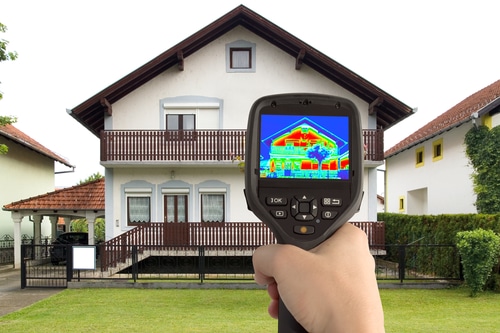The best thermal cameras enable you to view and measure temperature differences correctly and from a distance. They help identify heating sources in obscured or dark areas, whether you are trying to find problems to save on your heating charges. Thermal cameras have been in the market to identify people in a crowd by separating those that have feverish high temperatures.
An infra-red camera will let you explore your world in a whole new way. Beyond the visible spectrum, there is an invisible world of heat radiation. Artsy infrared digital photographs aside, the practical uses of this technology traditionally belonged to professional budgets & the military. But now thermal imaging can be used by anyone.
For the most part, the cameras work like standard ones, except that obscure IR light is turned into a visual “thermogram.” Thermal cameras however comprise image sensors with pixels, but beginning at lower resolutions (e.g., 0.003 megapixels, or 80×60 pixels). This is enough detail to pick hotspots in wiring, but higher resolutions are better for imaging like in safety and rescue scenarios. The detectors are also of varying detail — 150mK sensitivity implies each pixel takes readings to the nearest 0.15˚C, so lower numbers are always better.
Thermal Imaging functions in the dark, or via smoke, but can be tricked by the reflectiveness (emissivity) of a surface. As IR is part of the electromagnetic spectrum, such as visible light, it also has related properties when it meets lenses or rain. For professional usage, it pays to read up a little on understanding thermograms, but you’ll learn the fundamentals when you power-on your thermal camera. Based on the software, you can also take retrospective measurements from the thermal JPEGs.
1. FLIR One Gen 3 – $200
Dimensions: 34 x 67 x 14mm | Sensitivity Range: -20˚C to 120˚C (-4˚F into 248˚F) | Resolution: 80 x 60 pixels | Sensitivity: 150 mK.

A very fairly priced way to get hold of FLIR’s patented MSX technologies (which boosts the apparent resolution of low-end sensors) get the most out of your phone’s connectivity is the FLIR One.
Although there’s a ruggedized Pro version, fostering the resolution to 160 x 120 and offering a multitude of additional features (multiple measuring zones, manual exposure), the standard version is sufficient to allow you to discover and gauge the temperature visually — not only a helpful tool but endlessly fascinating also. Both models include a timelapse function, though of course, that’s limited by the battery life.
While the device looks good, there are some inelegant design options, not least because it has its own battery and has a separate power switch. On the other hand, that will mean that it will not steal much power from your precious battery. The knob that you might imagine to be a focus wheel adjusts the phone connector’s length to match your phone case thickness.
Video by: FLIR Systems, Inc.
In conclusion, busy contractors will need an electricity bank in the least or to look further down this list, but for the average user, this will be a lot to get a few clips or shots through the easy-to-use app. Your phone big touch screen for taking touch readings or, with the Flir One Pro, set regions of interest.
2. Seek Thermal CompactPro – $499
Dimensions: 41 x 20 x 15mm | Resolution: 320 x 240 pixels | Sensitivity: 70 mK | Sensitivity Range: -40˚C to 330˚C (-40˚F into 626˚F) | 15Hz refresh
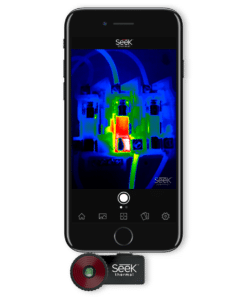
This little phone add-on gives higher sensitivity and more resolution than the FLIR equivalent (even the Pro one), making it a fantastic selection for contractors, engineers, and inspectors looking for that little more resolution. With an adjustable focus, the lens can be put on subjects so far as 550m (1,800feet ). That’s not just useful for outdoor pursuits, but lets you take advantage of the resolution to get sharp thermal images at any distance.
While the FLIR One comprises a visible light camera (required to the MSX technician ), the Seek CompactPro uses your phone’s camera to deliver a split-screen picture-by-picture feature, which can be subject to some parallax difficulties. On the plus side, the 15Hz refresh rate makes for the superior movie (but can increase export problems when departing the US as it becomes “military-grade”). The app can provide center-spot measures or automatically highlight the hottest and coldest spots.
3. FLIR C-Series – $499
Dimensions: 124 x 79 x 25mm | Resolution: 80 x 60 pixels | Sensitivity: 100 mK | Sensitivity Range: -10˚C to 150˚C | Battery: 2 hours rechargeable.
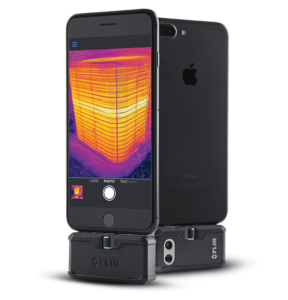
With a rugged body that will survive a little bit of workplace rough-and-tumble, the FLIR C2 or C3 is good-looking, compact thermal imagers ideal for contractors and DIYers. Both have two cameras, the 80×60 IR and a 640×480 optical, enabling it to take advantage of the MSX technology of Flir. This patented method implements an edge-detection algorithm on the higher-resolution visual light image. The visual camera can also offer a picture-in-picture option. Obviously, the low resolution boosted with visual-only works in a good light. Thus a small LED light is given, but that only offers limited assistance.
Both models have a 3-inch touchscreen and can save around 500 images onboard to transfer through Micro USB. Still, if you can expand to it, the C3 model appends more analysis characteristics and Wi-Fi to get pictures on your phone and to your software. FLIR Tools, FLIR’s analysis software, permits you to alter the color patterns and note readings from 4,800 measurement points in the picture files. FLIR Tools is compatible with Android, iOS, and Windows, but the Mac version was discontinued.
4. Seek Thermal RevealPRO – $799
Dimensions: 127 x 61 x 31mm | Resolution: 320 x 240 pixels | Sensitivity: 70 mK | Sensitivity Range: -40˚C to 330˚C | Weight: 117g | Battery: 4 hours rechargeable
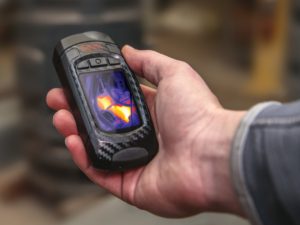
This is a flexible, portable thermal camera with superior resolution, meaning it is just as useful at night as during the day. While the FLIR C-Series creates useful images in good light via MSX, this camera can do that at any time as it doesn’t rely on visible light to boost its resolution. Coupled with its 15Hz refresh rate (most are 9Hz), it can be used to spot people or animals in the dark, or through dense foliage, exactly like the Predator does! There is also a 300 lumen LED light on if you wish to surprise someone you’ve detected in the dark.
The simple menu system offers access to other helpful features, such as Level and Span adjustments (somewhat like manual exposure, enabling you to isolate a thermal range), and Emissivity adjustments (manual or presets). The fixed-focus camera functions between 30cm and 550m, and the 2.4-inch color display is shielded with Gorilla Glass. The 4GB memory can take as many pictures as you want to (you can hold down the shutter if you like). For distance temperature readings, you may use the 4x digital zoom (although the resolution suffers).
5. FLIR TG267 – $500
Dimensions: 210 x 64 x 81mm| Battery: 5 hours rechargeable| Resolution: 160 x 120 pixels | Sensitivity: 70 mK | Sensitivity Range: -25˚C to 380˚C
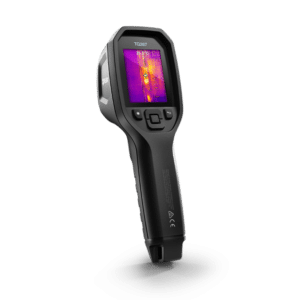
Featuring a continuous-scanning IR thermometer and laser, this design is a sort of combination between a thermal imaging camera and a non-contact thermometer.
The grip shape is suited to car maintenance tasks since the one-handed use is simple, and the cool bullseye-shaped laser dot makes it easy to address the point of interest. The 2.4-inch color display (refreshing at 8.7Hz) provides tons of confidence that you are getting the perfect readings for your work, boosted by the MSX tech for a sharp view.
The generous battery provides five hours use in the workshop, and charges through the same USB connector which can be utilized to offload the stored images – up to 50,000 of which will adjust on the built-in 4GB. The system also enables for emissivity correction (manually or with 4 handy presets) and includes a tripod mount in the base of the grip.
Enthusiast Mechanics might prefer to look down the cheaper TG165, an old FLIR product pointed at this category, which yet features a laser and IR thermometer. At the same time, the nearly-similar TG275 can perceive an even higher temperature range.
6. Seek Thermal ShotPro – $500
Dimensions: 80 x 140 x 28mm | Sensitivity Range: -40˚C to 330˚C| Resolution: 320 x 240 pixels | Sensitivity: 70 mK | Weight: 205g | Battery: 4 hours rechargeable

The Seek ShotPRO is a compact IR camera that boasts a better resolution than its rivals but, unlike any accessibly-priced Seek products, also includes the ability to combine visual lighting. SeekFusion, the tech permits you to correct an overlay with an onscreen slider, little like changing opacity in Photoshop layers. It does not have of FLIR MSX’s edge-enhancement, but on the other hand, the larger thermal resolution means that it isn’t really needed.
The Short Pro, such as the FLIR C3, is effective at Wi-Fi streaming (it partners with a free app named SeekView), though it still comprises 4GB memory to capture video and stills. Even without the app, the 3.5-inch touchscreen may be used with the integrated analysis tools; you can produce up to three boxes and track minimum, maximum, and average temperatures in each. Using the tripod-mount, this can be useful for watching things change over time.
7. Parrot Anafi Thermal – $1900
Dimensions: 241 x 67 x 64mm | Sensitivity Range: -10˚C to 400˚C| Resolution: 160 x 120 pixels | Sensitivity: 50 mK | Weight: 315g | Battery: 5 hours rechargeable

Given one of the most popular thermal cameras applications, it recognizes people for search-and-rescue, it looks only right to include a drone in this list. Suppose you’re looking for a (reasonably priced) way into this market. In that case, you have an option between the Anafi Thermal and the DJI Mavic 2 Enterprise Dual, both of which comprise a FLIR Lepton 3.5 into broadly unchanged models of the popular drones.
While there are great reasons to like the DJI offering, the Mavic’s scores a few extra points, not least the notably cheaper price point. Along with its 4K visual camera provides a lossless zoom – good for search and rescue – and there are a total of three batteries included enabling over an hour of flight time.
If money is no object, though, the DJI is well worth a look too, particularly for nervous fliers as it has collision-avoidance systems.

